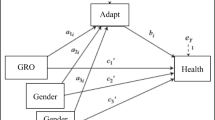Abstract
Health psychologists often content that men are more vulnerable to the effects of stress than are women. One explanation of this male risk factor deals with the masculine role — the set of values, beliefs, and expectations traditionally associated with men's lives. The present study was conducted to determine whether the restrictive emotionality, success preoccupation, and inhibited affection aspects of the masculine role, measured by the Masculine Role Inventory [MRI; W. E. Snell, Jr., “The Masculine Role Inventory (MRI): Components and Correlates,” Rex Roles, 1986] increase not only men's but also women's vulnerability to the effects of stressful life experiences. The results indicated that among both men and women with a recent history of stressful experiences in their lives, the masculine role was associated with elevated distress.
Similar content being viewed by others
References
Antill, J. K., & Cunningham, J. D. Self-esteem as a function of masculinity in both sexes. Journal of Consulting and Clinical Psychology, 1979, 47, 783–785.
Belk, S. S., & Snell, W. E., Jr. Stereotypic beliefs about women as moderators of stress-distress relationships. Paper presented at the annual meeting of the Southwestern Psychological Association, Ft. Worth, Tex., April 1986.
Belk, S. S., & Snell, W. E. Jr. Avoidance strategy use in intimate relationships. Journal of Social and Clinical Psychology, in press.
Brannon, R. Our culture's blueprint of manhood and what it's done for us lately. In D. Davis & R. Brannon (Eds.), The forty-nine percent majority: The male sex role. Reading, Mass.: Addison-Wesley, 1976.
Bugen, L. A., & Hawkins, R. C. The Coping Assessment Battery: Theoretical and empirical foundations. Paper presented at the annual meeting of the American Psychological Association, Los Angeles, Calif., August 1981.
Finney, J. W., Mitchell, R. E., Cronkite, R. C., & Moos, R. H. Methodological issues in estimating main and interactive effects: Examples from coping/social support and stress field. Journal of Health and Social Behavior, 1984, 25, 85–98.
Goldberg, H. The hazards of being male. New York: New American Library, 1977.
Harrison, J. Male sex role and health. Journal of Social Issues, 1978, 34, 65–86.
Jones, W. H., Chernovetz, M. E. O., & Hansson, R. O. The enigma of androgyny: Different implication for males and females? Journal of Consulting and Clinical Psychology, 1978, 46, 298–313.
Jourard, S. M. The transparent self. New York: Van Nostrand, 1971.
O'Neil, J. M. Male sex role conflicts, sexism, and masculinity: Psychological implications for men, and women, and the counseling psychologist. The Counseling Psychologist, 1981, 9, 61–80. (a)
O'Neil, J. M. Patterns of gender-role conflict and strain: Sexism and fear of femininity in men's lives. Personnel and Guidance Journal, 1981, 60, 203–210. (b)
Sarason, I. G., Johnson, J. H., & Giegel, J. M. Assessing the impact of life change: Development of the Life Experiences Survey. Journal of Consulting and Clinical Psychology, 1978, 46, 932–946.
Silvern, L. E., & Ryan, V. L. Self-related adjustment and sex-typing in the Bem Sex Role Inventory: Is masculinity the primary predictor of adjustment? Sex Roles, 1979, 5, 739–763.
Snell, W. E., Jr. The Masculine Role Inventory (MRI): Components and correlates. Sex Roles, 1986, 15, 359–366.
Snell, W. E., Jr., Belk, S. S., & Hawkins, R. C. II. Drug dependency in stressful times: The influence of the masculine role and sex-related personality attributes. Unpublished manuscript, the University of Texas at Austin, 1986.
Spence, J. T. Masculinity, femininity, and gender-related traits: A conceptual analysis and critique of current research. In B. A. Maher (Ed.), Progress in experimental personality research (Volume XIII). New York: Academic Press, 1984.
Spence, J. T., & Helmreich, R. L. Masculine instrumentality and feminine expressiveness: Their relationships with sex role attitudes and behaviors. Psychology of Women Quarterly, 1980, 5, 147–163.
Spence, J. T., & Sawin, L. L. Images of masculinity and femininity: A reconceptualization. In V. O'Leary, R. Unger, and B. Wallston (Eds.), Sex, gender and social psychology. Hillsdale, N.J.: Erlbaum, 1984.
Spence, J. T., Helmreich, R. L., & Stapp, J. Ratings of self and peers on sex-role attributes and their relation to self-esteem and conceptions of masculinity and femininity. Journal of Personality and Social Psychology, 1975, 32, 29–39.
Waldron, I. Why do women live longer than men? I. Journal of Human Stress, 1976, 2, 1–13.
Waldron, I., & Johnson, S. Why do women live longer than men? II. Journal of Human Stress, 1976, 2, 19–29.
Whitley, B. E., Jr. Sex-role orientation and self-esteem: A critical meta-analytic review. Journal of Personality and Social Psychology, 1983, 44, 773–786.
Whitley, B. E., Jr. Sex-role orientation and psychological well-being: Two meta-analyses. Sex Roles, 1985, 12, 207–225.
Author information
Authors and Affiliations
Rights and permissions
About this article
Cite this article
Snell, W.E., Belk, S.S. & Hawkins, R.C. The masculine role as a moderator of stress-distress relationships. Sex Roles 15, 359–366 (1986). https://doi.org/10.1007/BF00287977
Issue Date:
DOI: https://doi.org/10.1007/BF00287977




